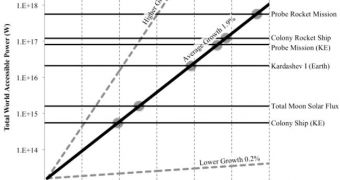Traveling among the stars has been a goal in itself for humankind since the earliest days, but it wasn't until the beginning of the Space Age that the possibility of visiting other worlds entered the realm of reality. Now, an estimate shows that at least two centuries will pass until we reach that objective.
Experts behind the new paper calculated the amount of energy and innovation we would need to visit other stars, and generally make our presence known in the solar system and beyond.
Their calculations show that 200 years represent the most appropriate interval for our species to collect sufficient knowledge and energy to dare venture towards other stars. But this is an optimistic estimate, they add.
Just like UN predictions of how much the world's population would grow by 2050, there is a great deal of uncertainty in the new calculations, and they have a low, average and high curve to prove it. In other words, it all depends on how much we want to spread among the stars.
This estimate was compiled by the former head of the Breakthrough Propulsion Physics Project at NASA, Marc Millis. He is also the founder of the Tau Zero Foundation, an organization dedicated to supporting interstellar travel and related scientific endeavors.
One of the main mechanisms through which such studies are conducted is extrapolation. Experts analyze how much average spacecraft speed is increasing in proportion to the many being invested in space exploration, and then predict when the two will be sufficiently high to allow for exploring space.
The two issues associated with visiting other stars are distance and cost. The nearest worlds worth visiting are tens of light-years away. On the other hand, it costs a lot of money to build a fast motor.
Sadly, all studies into how long it would take for humans to reach other stars have until now come up with similar answers – centuries. There is apparently to no way to break this vicious circle either, Technology Review reports.
“This study found that the first interstellar mission does not appear possible for another 2 centuries,” Millis says, adding that the year 2196 is when sufficient energy will be available to allow for at least one mission to another star.
Such studies put a dent in some people's plans of exhausting the resources Earth has to offer, and then move forward in space, colonizing another planet. The requirements associated with building a colony spaceship are too monumental to even mention.

 14 DAY TRIAL //
14 DAY TRIAL //